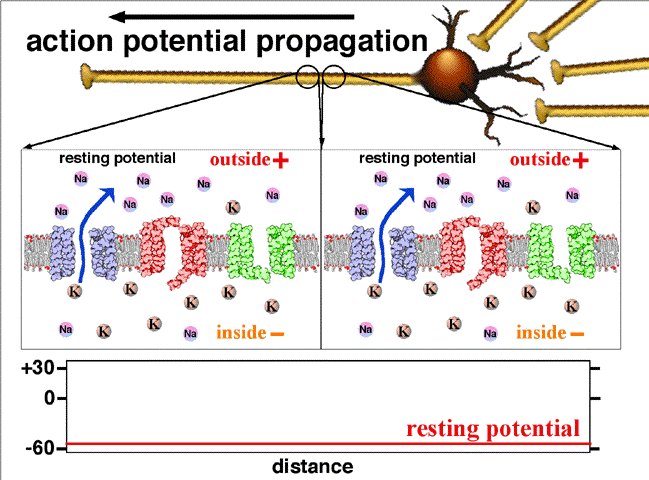The functions of neurons depend on the movement of ions across the membrane. This happens both passively and actively across the membrane of a neuron. Lets talk about the passive process first. There are 2 factors that control the passive movement of ions across the membrane. Those 2 factors are diffusion and charge.
Because inside the cell is negatively charged, that will pull Potassium (K+) into the cell. However, Diffusion pulls it outside of the cell. This causes an equilibrium to be established when the rate of movement by diffusion equals the rate of movement by charge. This point is called the Isoelectric Point.
Isoelectric point
The Isoelectric point of a protein is the pH at which it has a net charge of zero. If there are a lot of carboxyl groups, the isoelectric point will be more acidic. Intracellular proteins in most cells have an average isoelectric point of 4.5 – 4.7. Cellular pH is 7.2. This gives the proteins in a cell a negative charge.
Membrane potential (Em) = charge across the membrane.
Resting potential (Erest) = membrane potential of a resting nerve cell.
In resting neurons the membrane potential ranges between -50-80mV
Lets look at how the Donnan equilibrium is established. Lets say that we are starting off with + charged ions outside the cell. There is an electrical charge inward (due to the negative charge inside the cell), and a movement by concentration inward. The internal concentration increases. There will come a point where the concentration inside and outside will be equal. However, there will still be an inward movement due to charge.
Eventually, the concentration of that ion will be greater on the inside than outside. At this point, diffusion will then send the ion out. The charge inside is becoming less negative. There will come a point where the outward movement by concentration gradient equals the inward movement by concentration. This point is the Donnan equilibrium for that particular ion.
How the Equilibrium Potential leads to an action potential
The resting membrane potential of a neuron is approximately -60mV. The Equilibrium potential for Na+ is approximately 58mV. This means that the membrane potential is far away from the equilibrium potential for Na+. This will result in a force trying to move Na+ into the cell because Na+ wants to be at its equilibrium. It’s where the ion is most “comfortable”.
The force to move ions across membranes = Em – Eion = Driving force (DF). So the DF for Na+ will be -118mV. If the channels are opened, Na+ will rush into the cell until DF = 0 at 58 mV (all or nothing). This is where we get the force necessary to cause an action potential to happen.
I know we are getting kind of technical here, but that’s what we do. The workings of a neuron are pretty complex, and the Donnan Equilibrium is an important concept in the process of generating signals (action potentials) in neurons.
Here’s an animation of an action potential in a neuron. I will get into the details of the animation in another article.

